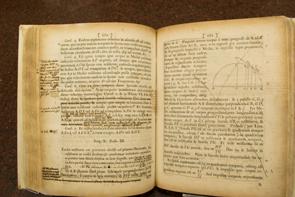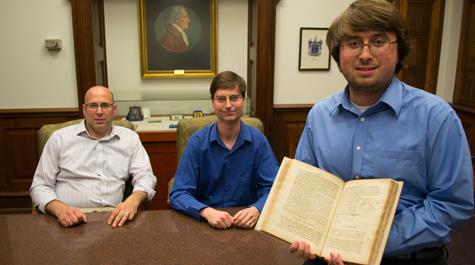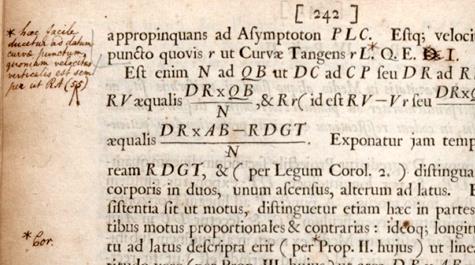Whodunit: What learned hand wrote all over Isaac Newton’s masterpiece?
There is a bit of a mystery surrounding a book at William & Mary.
The Special Collections Research Center in Swem Library is home to a first-edition copy of Isaac Newton’s Philosophiæ Naturalis Principia Mathematica, perhaps better known by its nickname — the Principia. There are only a very few known first-edition copies of the Principia in the world. One copy was donated to William & Mary in 1869.
“Our copy has been professionally conserved,” said Susan Riggs, Frances Lightfoot Robb Special Collections Librarian. “And it contains numerous Latin manuscript notes, marginalia, and corrections in ink and pencil.”
Therein lies the whodunit: Who is the mysterious author or authors of these copious annotations, edits and sometimes very strange markings that appear throughout the text? A trio of scholars at William & Mary — a historian, a physicist and a Latin-literate physics student — is working with Special Collections to identify the mystery annotator.
First published in 1687, the Principia is widely regarded as one of the most important works in the history of science. Physicist Joshua Erlich says Isaac Newton stands apart from perhaps any other scientist until Einstein — simply for the breadth, depth and longevity of his scientific contributions.
“Newton’s Principia is arguably the most important scientific document yet written,” Erlich said. “The tremendous scope of brilliant new observations, ideas and mathematics presented in the text is unmatched, including the rules governing the motion of objects both on Earth and in the heavens, oscillations, fluids, waves and the Law of Universal Gravitation.”
Indeed, Newton’s Laws are the basis of classical mechanics, which to this day remains the first subject that students of physics encounter in their education.
“Newton’s Laws have been responsible for the discovery of planets, for the construction of safe bridges, roads and amusement park rides, for an understanding of the ocean’s tides, and for realistic computer animations and video games,” said Erlich, the Class of 2017 Associate Professor of Physics. “It would be difficult to overstate the importance of at least some of these things.”
 After the first edition (hereafter referred to as Newton 1), two subsequent editions were published. The second edition (Newton 2) was published in 1713 and the third edition (Newton 3) in 1726. Then, just over a decade later, comes Newton 4, the so-called Jesuit edition, which was edited by two Minim friars. The Jesuit edition contains commentary that extends to roughly the same length as Newton’s text. The text for the Jesuit edition was, in fact, taken from the Newton 3 edition of the Principia — the last edition to be edited by Newton himself.
After the first edition (hereafter referred to as Newton 1), two subsequent editions were published. The second edition (Newton 2) was published in 1713 and the third edition (Newton 3) in 1726. Then, just over a decade later, comes Newton 4, the so-called Jesuit edition, which was edited by two Minim friars. The Jesuit edition contains commentary that extends to roughly the same length as Newton’s text. The text for the Jesuit edition was, in fact, taken from the Newton 3 edition of the Principia — the last edition to be edited by Newton himself.
As with any good mystery, some pieces of the puzzle are missing altogether. There are enough details about the annotated book that Erlich, along with historian Nicholas Popper and physics major Jackson Olsen ’16, could get at least get a start toward a solution.
“Our Principia has an interesting story,” Olsen said. “It is mysterious because we don’t know who wrote these comments or exactly when they wrote them. We also don’t know the particular physics this person was interested in — so there is a lot of opportunity here for others to get involved, to flesh out this narrative of our Principia.”
Like other scientific books of the era, the Principia is written in Latin, a language that was common among educated people throughout Europe. The annotations are also written in Latin and, based upon the style of handwriting, are believed to date to the 18th century. Other marks include additions, corrections, synopses or quotes. Some of the marks are very distinctive and unusual.
“This text is really, really hard and very technical,” said Popper, an assistant professor in the Lyon Gardiner Tyler Department of History. “There is huge literature on the interpretation of Newton, which suggests how people came to understand and familiarize themselves with it. The annotations indicate there is a kind of school of thought or specific areas of interest within the text that were driving the annotations.”
The Latin of the annotations also could be characterized as very technical — about the same Latin used in the service of mathematics — but not as complicated as the math, he said.
“The annotations are well thought out,” said Popper. “They are formal insofar as many are direct copies of passages from other works of the period into the margins of Principia.”
The annotator was not Newton himself — the notes are not in the author’s hand. In fact, Riggs says that the annotations are the work of at least two individuals.
“One concentrated on underlining words and filling in letters — perhaps a bored student,” she speculated. “And another 18th-century hand recorded copious notes, which can be reliably dated to 1720 or later, based on the mention of a scientific demonstration made in Paris in that year. The second annotator appears to have been knowledgeable, and it is those annotations that may be worthy of further study.”
When he began studying these annotations, Popper also began to wonder what other books were being compared with the Principia. And what, he wondered, was the goal of the annotators in introducing these marginal comments into the text? He learned that many of the annotations were actually based on Newton’s own corrections to Newton 2 or Newton 3. But some didn’t seem to fit this pattern. So Popper went back and took another look at the Jesuit edition.
“I saw that there was a close relationship between Newton 1 and the Jesuit edition, but it was different insofar as there didn’t seem to be verbatim corrections like the other ones were,” said Popper. “They often gestured at another text but did not provide nearly as much information as the scholarly apparatus of the Jesuit edition.”
Olsen noted that many of the annotations in W&M’s Principia are incorporating edits from Newton 3. “At first it appears as though someone wanted to get their first edition up to speed with the third edition,” he said. “But it’s more than that.”
“The updates from Newton 1 to Newton 3 are more stylistic edits and words have been changed around,” said Olsen. “There is one section where Newton did an experiment involving pendulums that was documented in the Newton 1. Then, by Newton 3, he had conducted the experiment again because there was different data in Newton 3. Our annotator thought that was interesting and worthwhile enough that he went through and changed the numbers in Newton 1.”
Olsen also uncovered an instance where a name in the Swem commentary was in a different grammatical case than the Jesuit version.
“With nouns in Latin, the ending of the word changes based on what it is doing in the sentence,” he explained. “So a direct object has one ending and a subject has another ending. This name had one ending and was using one grammatical structure in our comments but another in the Jesuit comments.”
The case-changing was, Olsen thought, a very peculiar thing to do for someone copying edits from a later edition.
“You wouldn’t change the grammatical structure of the sentence you were copying,” Olsen continued. “What’s more likely is that you are going through our edition and you are making these comments and then you go to your other collaborators on the Jesuit project and you say ‘I like this comment’ and they change the grammar structure. So this name was really a link between the annotations in ours and the Jesuit edition. It suggests to me that maybe ours came first and maybe the Jesuit edition comments are based on our comments.”
It was an exciting find for Olsen — who was at that point also looking through the comments in Swem’s Principia for any dates that appear — comparing those to the Jesuit edition to see if there were any clues.
“If someone is commenting on a particular date and it’s after the Jesuit edition came out, we can be pretty sure that this person wasn’t writing it before the Jesuit edition,” said Olsen.
A search revealed that none of the dates that appeared in the commentary in Swem’s edition were after the publication of the Jesuit edition. Annotations can prove to be valuable keys to the understanding of the original text.
“The thing I find most interesting,” said Popper, “is there is this whole method that is increasingly used amongst historians of trying to understand how books were interpreted by reading the annotations in them and by reading notes that people took of them.”
He said that such a method is a way for a historian to understand the book through the thoughts and circumstances of the reader — a person who belongs to the same historical period. Trying to get into the head of the reader is a tricky process for a historian, he added.
“What does it mean if someone underlines a passage — does that mean something is deeply true?” asks Popper. “Or is it deeply false? Unless you can really root the annotations or the comments in a specific context and tie them to a specific person, it is often difficult to be sure what they mean.”
Popper begin his study based on an idea that this annotator was preparing the text for a subsequent edition — perhaps one after the Jesuit edition — or even an edition that was never published.
“The interesting pieces include these annotations in the volume that look like they are for a printer preparing another edition,” says Popper. “There are notes entered into the volume that are updating it according to subsequent volumes of the text, including Newton’s own second and third editions and the Jesuit edition.”
He later revised his thinking.
“There are these really weird carets and weird numbers and different kinds of marks that are all over the text that are very difficult to explain,” said Popper. “These kinds of marks would usually be associated with a printer preparing a text for a new edition. But the actual content of the annotations no longer leads in that direction quite as emphatically as I thought previously — that just deepens the mystery a little more.”
What’s more, not all changes of the Newton 2 and Newton 3 are entered into W&M’s edition. The same is true of the commentary from the Jesuit edition.
“If there were sufficient interest to pursue it, I think there is a good chance that the primary annotator could be identified,” said Erlich. “There may be handwriting comparisons with persons conjectured to have written the notes; the type of ink used may help to identify when the notes were taken; and so on. But the intrigue of this whodunit is also fun.”
Obviously, it would help if the annotator(s) had written something perhaps along the lines of, “I went somewhere one day and bought this from that person” but such an identifying feature has not yet been found in Swem’s edition.
Jay Gaidmore, Swem Library’s Marian and Alan McLeod Director of Special Collections, believes it would not be outside of the realm of possibility for a student, faculty or other scholar taking on the project to someday identify the annotator, working along lines similar to the project that described the purposes of the annotations.
“A dissertation focused on the annotator or annotations is probably not feasible,” Gaidmore said. “But this could be part of a dissertation.”
“It would be a risky dissertation topic,” Popper agreed. “Because how can you defend something if you can’t figure it out in the end?”
Still, it might represent a research project that many scholars would love to sink their teeth into. Perhaps the fact that the annotated copy was recently digitized might lead some toward this mystery.
“The work is now up on Annotated Books Online,” Popper said. “That might help Newton scholars place it. It is really more of an undertaking for a professor or scholar who has that wish list of projects that he or she would explore if they had time.”
According to Gaidmore, Annotated Books Online was thrilled to have the Swem Principia added to their site. “Our hope is that the handwriting of the unidentified annotator will be recognized, leading to the identity of the annotator and a greater understanding of the annotations,” he said.
And so the search across centuries for the mystery annotator continues. Even if the annotator’s identity is never discovered — that aspect of what they were trying to do in their annotations will remain intriguing in and of itself.
A mystery within the mystery
There is even some mystery surrounding the Principia’s journey that eventually landed the book in Swem’s Special Collections.
In 1869, Rev. Dr. Thomas S. Savage donated the work to William & Mary. How did it fall into Rev. Savage’s possession and why did he donate it to the College? Historian Nicholas Popper suggests that the answers to those questions could help solve the greater mystery that lies in the margins of the book.
“Savage’s papers are at UNC Chapel Hill and there are a lot of them, so a scholar would need a lot of time to sift through voluminous records. Perhaps there is some note in the collection or a clue leading to others who might have crossed paths with someone who might know how Savage came to donate the work to W&M.”
The donor of the papers to the University of North Carolina in 1974 was a portrait artist named Thomas Casilear Cole (1886-1976). He was Rev. Savage’s great nephew.
The William Rutherford Savage papers #3999, Southern Historical Collection, The Wilson Library, University of North Carolina at Chapel Hill contain some 2,000 items spread across 2.5 feet of linear shelf space. The collection has not been digitized but information on the website clearly establishes Virginia and North Carolina connections within the family. We may never know how W&M came to be the beneficiary of this donation. We do know that the donor was a scientist — as were his parents — with ties to UVA and the Union Theological seminary of Virginia. Skip to main content
Skip to main content


